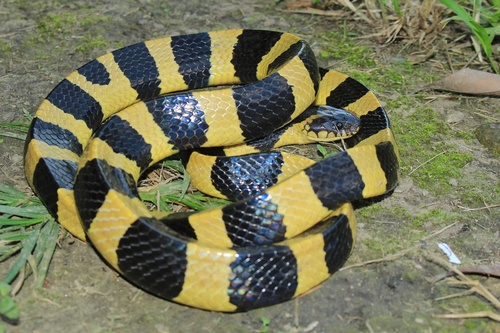
Banded krait
The banded krait, with its vivid black-and-yellow stripes, is a nocturnal hunter of other snakes in Asian wetlands and forests. This lethargic yet potent predator plays a crucial role in controlling snake populations, mesmerizing with its unique pattern and stealthy, night-time movements.
3 years
Age of Sexual Maturity
Medium
Aggression
Least Concern
Conservation Status
Stable
Population Trend
Characteristics
Bungarus fasciatus, commonly known as the banded krait, is a highly venomous snake found in South and Southeast Asia. It is distinguished by its striking black-and-yellow banding pattern. The banded krait prefers lowland forests and wetlands, is nocturnal, and has a diet primarily consisting of other snakes.
Distribution Range of the Banded krait
Bungarus fasciatus, commonly known as the banded krait, is native to South and Southeast Asia. Its geographical distribution includes countries such as India, Bangladesh, Myanmar, Thailand, Laos, Cambodia, Vietnam, Malaysia, and Indonesia. It is also found in southern China, specifically in Yunnan Province.
Banded krait's Habitat
Environmental Conditions
The banded krait typically inhabits a variety of environments ranging from forests and agricultural lands to villages and rural areas. It is often found near water bodies like rivers, streams, and lakes. The species prefers humid and warm climates typical of tropical and subtropical regions.
Ecological Niche
Bungarus fasciatus is a terrestrial snake that primarily occupies the forest floor and low-lying areas. It is nocturnal and known for its secretive and slow-moving behavior during the day, becoming more active at night. It feeds mainly on other snakes, including both venomous and non-venomous species, as well as small mammals and occasionally amphibians, positioning itself as a mid-level predator in its ecosystem.
Copyright @ Nature Style Limited. All Rights Reserved.
 English
English